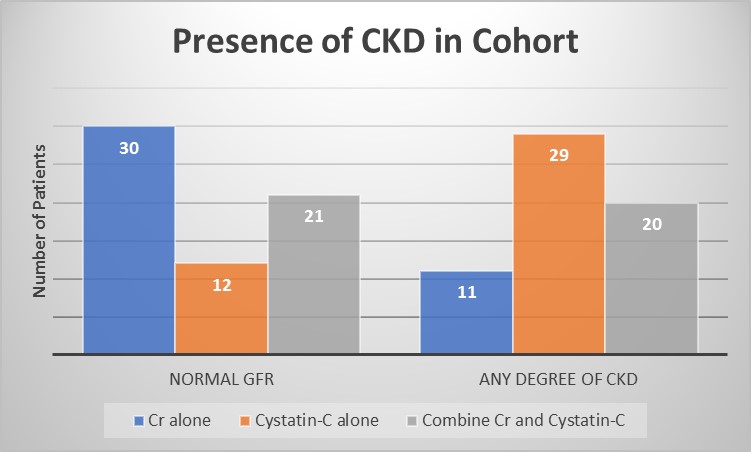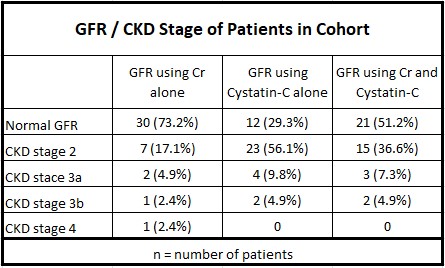Renal Function and Chronic Kidney Disease in the Pediatric Neurogenic Bladder Population: A Pilot Study
Devon Thomas, MD1, Seyed Behzad Jazayeri, MD1, Bryce Baird, MD2, Victor Chalfant, MD3, Preeya Mistry, MD4, Andrew A. Stec, MD4.
1University of Florida, Jacksonville, Jacksonville, FL, USA, 2Mayo Clinic Florida, Jacksonville, Jacksonville, FL, USA, 3Southern Illinois University, Springfield, IL, USA, 4Nemours Children's Health, Jacksonville, FL, USA.
Background As many as 25-50% of patients with neurogenic bladder (NGB) secondary to spinal pathology may develop kidney dysfunction during their lifetime (Chu). It is generally accepted practice to monitor renal function with annual creatinine (Cr) measurements starting during adolescence. However, Cr depends on muscle density which is often lower than predicted for age or height in this population. Cystatin-c is an alternative for measuring renal function that is independent of gender, height, age, muscle mass and is widely accepted in the pediatric nephrology community. This study evaluates the incidence of abnormal GFR in a pediatric cohort of NGB patients and the potential mis-estimation of renal function when assessed using Cr vs. Cystatin-C based equations. MethodsEnterprise wide EMR data identified a cohort of patients ≥2 and ≤18 years of age with a diagnosis of NGB due to primary spinal cord pathology. Primary inclusion criteria was GFR evaluation by both Cr and Cystatin-C data for paired comparison. Patients with bladder reconstruction / augmentation were excluded so the cohort represented the typical uncorrected clinical population. GFR was calculated based on three equations endorsed by the National Kidney Foundation. Cr alone GFR by the Bedside Schwartz equation; Cystatin-C alone using the Siemens (Date Behring) method, and a combined Cystatin-C and Cr equation from the CKid study. Patients were then stratified by GFR and the WHO CKD stage designations. ResultsForty-one patients with spinal cord based NGB without reconstructive bladder surgery were identified: 22 females and 19 males aged from 2-18 years.
Using Cr alone, 30 (73.2%) had normal GFR (>90 ml/min), with a 26.8% rate of decreased GFR / CKD stage 2 or greater. Using the Cystatin-C equation, 70.7% (29 patients) demonstrated some degree of CKD. Using the CKid combined formula with Cr and Cystatin-C, approximately half of the patients had normal GFR and half of the cohort had reduced GFR (Table 1)
Evaluating higher stage CKD (3b and 4), all 3 equations properly identified the same 2 patients in the cohort. The mean paired GFR values for the three equations, Cr only = 118 ± 58 ml/hr, cystatin-C only = 79 ± 20ml/hr and combined = 92 ± 28ml/hr.
ConclusionsPediatric patients with NGB secondary to spinal pathology have an incidence of CKD and decreased GFR of 48% when combining Cr and cystatin-C. Serum creatinine measurements alone potentially miss 22-44% of patients with CKD. Most missed cases are CKD stage 2. Cr alone is likely not sensitive enough to diagnose CKD in this population due to inherent low muscle mass. Using cystatin-c and creatinine measurements in combination to evaluate GFR likely results in a more comprehensive screening net for CKD and should be considered as routine surveillance in this vulnerable population.


Back to 2023 Abstracts
